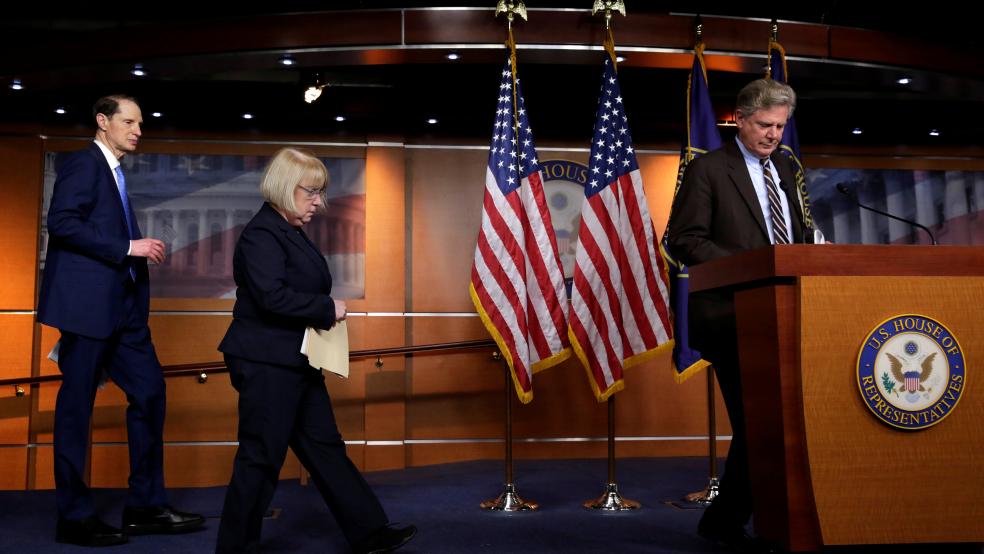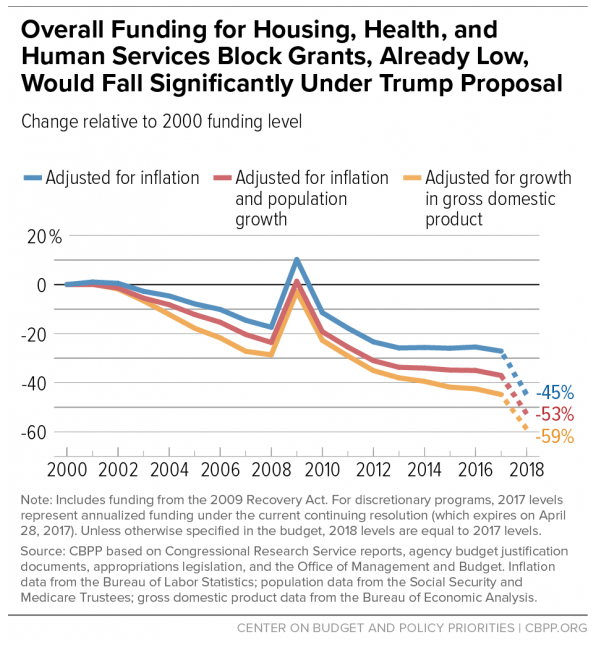The budget proposals coming out of the Trump White House over the past two weeks, whether official or floated as “options” to the administration’s negotiating partners, have been uniformly stingy when it comes to programs meant to benefit low-income workers and the very poor. A new analysis from the Center on Budget and Policy Priorities goes beyond the topline numbers to illustrate just how historically harsh some of the proposals are.
The left-leaning think tank focused on what the Trump administration referred to as its “skinny budget,” an outline of its planned budget request for the fiscal year 2018, and found that it would sharply accelerate the already downward trend in funding, usually contained in block grants, for state-level programs serving those in need.
Related: Did Trump’s Budget Chief Say Cutting Meals Programs Is ‘Compassionate’?
In sum, the proposal would slash discretionary funding for four different block grant programs, and appears to presage other reductions as well. The total money available to the four programs would be halved in 2018.
The reductions will hit programs that have seen their funding reduced almost every year for a decade and a half, except for a single-year spike in 2009, as the government moved to help those impacted by the financial crisis.
The grant programs identified by CBPP include the Low Income Home Energy Assistance Program, which helps poor people pay for heating in the winter, and the Community Development Block Grant program, which provides funds that are used to benefit a smorgasbord of programs, including after-school activities, meals on wheels and more. Those cost $3.4 and $3 billion annually.
It would also hit two smaller programs: the Home Investment Partnership Program, a $948 million fund that supports housing rehabilitation and affordable housing, and Community Services Block Grant, a $714 program that supports anti-poverty initiatives.
“Eliminating these four block grants would cut overall funding for discretionary block grants by $8.0 billion — or 47 percent — from its $17.2 billion level in 2017,” the CBPP report finds. “That 47 percent doesn’t account for inflation or any cuts, rather than outright eliminations, to block-grant programs that may flow from the austere discretionary funding targets that the President has set for most federal departments and agencies.” [Italics in the original.]
Related: Why Another Government Shutdown Is Suddenly in the Cards
Over the years, the push to block grant federal programs has resulted in more and more direct spending of federal dollars being delegated to the states. Lawmakers at the federal level cite the flexibility the grants provide states as a benefit, allowing those closest to the problems in the communities being served to determine how to allocate resources.
Ironically, that has also led to a decrease in the amount of those dollars flowing to the states.
“Frequently, policymakers cite the very flexibility that block grants provide to state and local governments as their reason to cut or end them,” CBPP notes. “The increased flexibility and diminished accountability over using federal funds that are built into the basic structure of many block grants mean that states can use the funds in highly diffuse ways, making a block grant’s impact much harder to assess. That, in turn, can eventually prompt federal policymakers who are seeking budget cuts to target block grants and argue that block-grant programs lack sufficient evidence of effectiveness.”
It’s a strategy on display again with the Trump administration. In discussing the budget proposal last week, Office of Management and Budget Director Mick Mulvaney was asked how the White House could justify cutting funding for programs like Meals on Wheels or after school food programs for hungry children.
The problems, he said, is that there is no evidence that they are effective.






